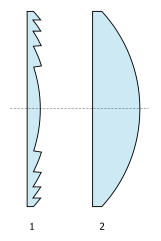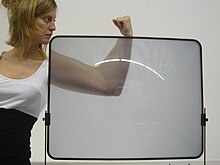Q: What is the Fresnel lens ?
A: The fresnel lens is a flat and slim optical lens are different with traditional glass lens which is heavy and thicker, it is originally developed by French physicist Augustin-Jean Fresnel for lighthouses.
The fresnel lens made by many engraved groove on the flat plate which Each groove is at a slightly different angle than the next and with the same focal length in order to focus the light toward a central focal point. Every groove can be considered as an individual small lens to bend parallel Fresnel light waves and focus the light.
Fresnel lenses are usually made of glass or plastic; their size varies from large to small. In many cases Fresnel lens are very thin and flat, almost flexible, with thicknesses in the 1 to 5 millimetre range.

Application of Fresnel Lens
The applications for Fresnel lenses include simple magnifiers, lighting and lamp, lighthouse, overhead projector, TV projection, condenser system, camera fresnel spotlight, automobile headlight, fresnel lens solar energy, rear projection Fresnel screen, passive motion detector, traffic sign, fresnel lens photovoltaic, fresnel solar concentrator, collimator, fresnel flight simulator, optical landing system, etc
Types of Fresnel Lenses
There are a lot of types of Fresnel lens, such as: positive Fresnel lens, negative Fresnel lens, Fresnel lens array, cylindrical Fresnel lens, circular Fresnel lens, linear Fresnel lens, lenticular Fresnel lens, diffraction Fresnel, Fresnel reflection, Fresnel beamsplitter and Fresnel prism.
Advantages of Fresnel Lens
The Fresnel lenses can be applied to designs and manufactured in very large sizes with light weight due to less than 4mm thickness, lower cost than traditional magnifiers and significant lesser weight. In contrast, a conventional glass lens would be 200mm thick and weigh over 50kgs and cost thousand of dollars, sacrificing convenient.
Significantly reduced lens thickness results in a substantial savings in material cost. Fresnel lenses can reduce weight, which reduces mounting and assembly cost. Extremely giant Fresnel lens up to 1000mm can be used to replace a very expensive conventional mirror assemblies in large optical systems.


